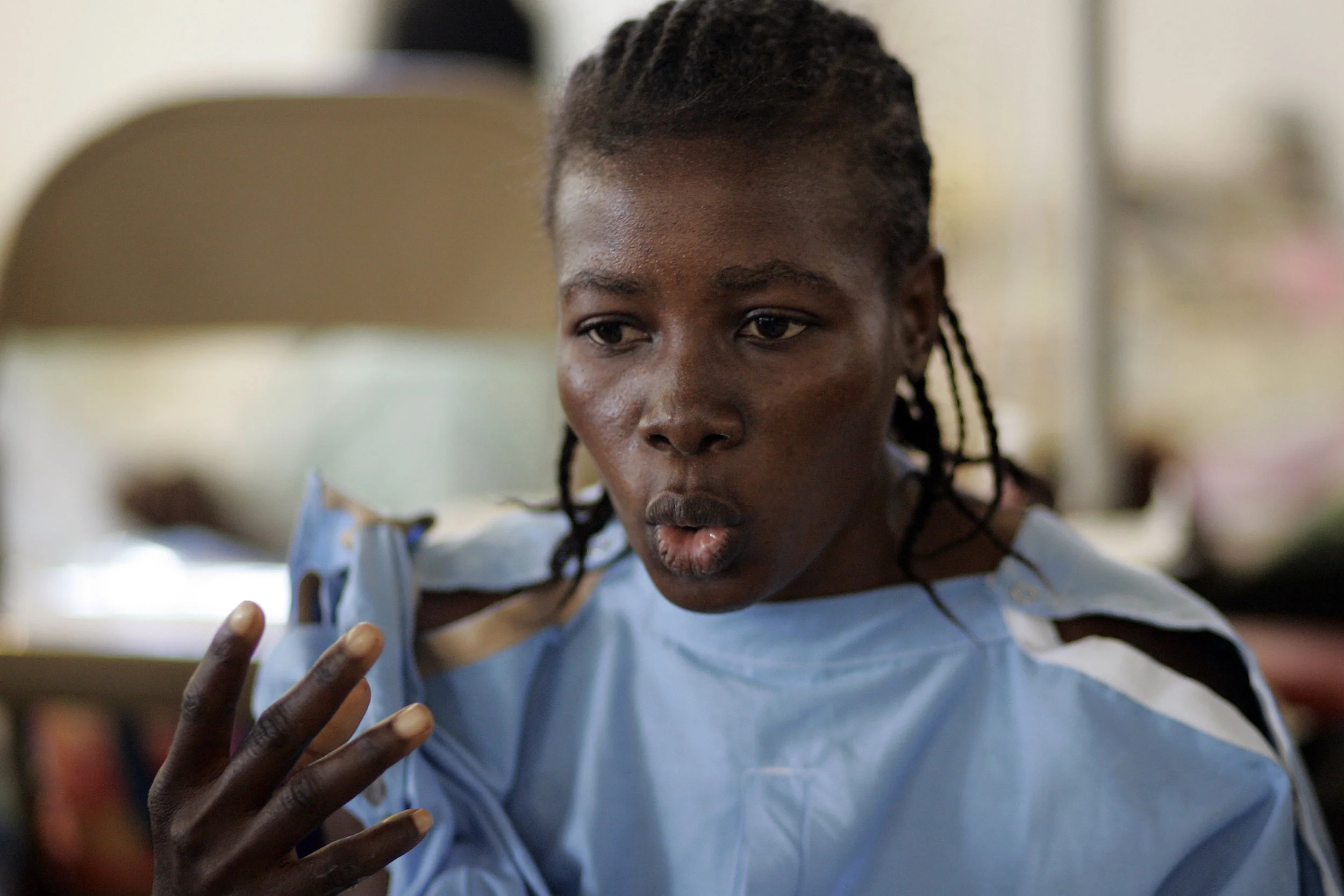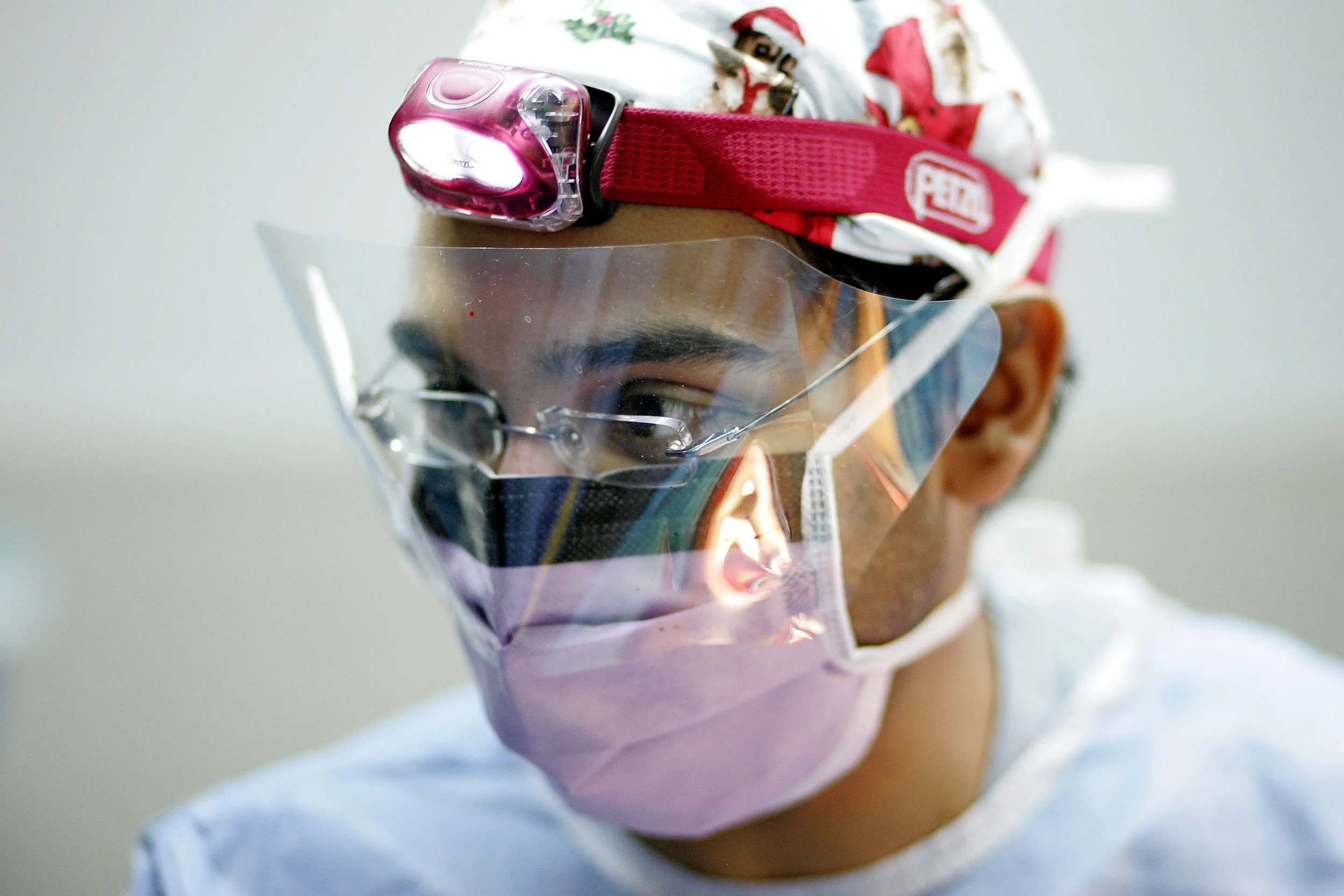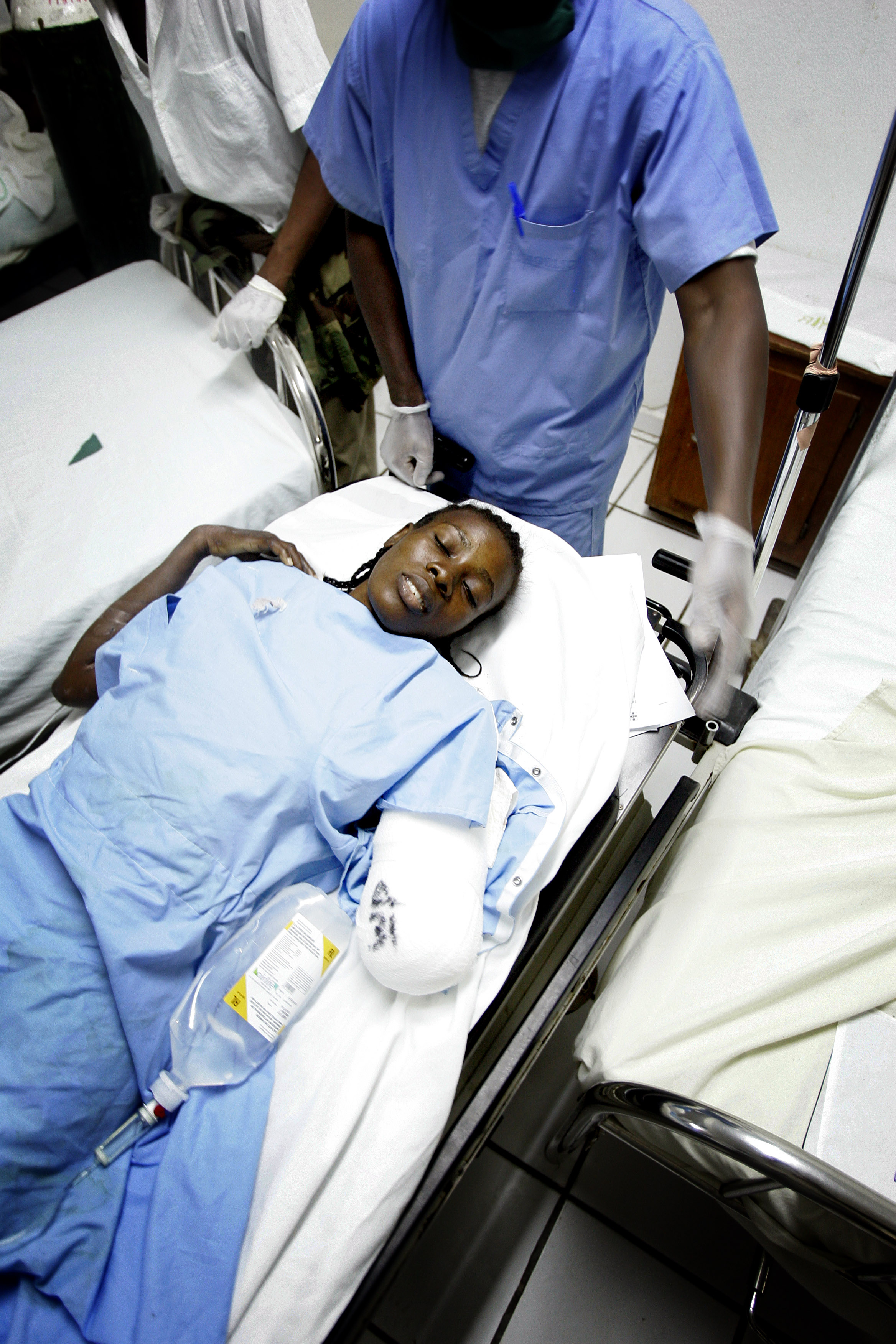Haiti earthquake victim’s choice is life, or limb
Sonia Donatien in triage at Bon Saveur Hospital. (Photo: David Swanson)
By Michael Matza
CANGE, Haiti - Dressed in a blue hospital johnny, Sonia Donatien sat on a mattress on the floor of Bon Sauveur's church, her limp left arm lying across her lap.
Buried in rubble for two days after the earthquake hit Haiti, Donatien now faced a decision that could change the rest of her life.
Her aunts Lorette and Rosalie, their hair wrapped in silky scarves, beseeched her: Do not let the doctors cut off your arm!
The "crush injury," squeezing the life out of her arteries, veins, and nerves, is one of the signature maladies caused by the Jan. 12 quake, a disaster that has evolved from a mass-casualty emergency to a crisis managing secondary medical problems, such as infections from untreated wounds.
(Photo: David Swanson)
As luck would have it, Donatien, a 32-year-old maid, was scheduled for surgery Wednesday at this provincial hospital, three hours from Port-au-Prince, by a medical team from a First World powerhouse, the University of Pennsylvania Health System in Philadelphia.
But that didn't make her decision any easier. Would she insist on another fasciectomy, a wound-cleaning procedure doctors thought would be useless? Or would she allow the amputation necessary to save her life?
Samir Mehta, 34, the Bensalem-born chief orthopedic surgeon on the Penn team, could only guess at the thoughts haunting her.
"'What will I look like? How will I work? How will I button my pants?' All of these things are going through a patient's mind," he said. "The only time we push for an amputation is when it's a matter of saving a life over saving a limb."
"'What will I look like? How will I work? How will I button my pants?' All of these things are going through a patient's mind."
— Dr. Samir Mehta
(Photo: David Swanson)
A cascade of rubble
When the earthquake fractured Haiti, Donatien was lying on the top floor of a three-story building in Port-au-Prince, taking a break from cleaning. As violent tremors collapsed the building, she spilled to the ground in a cascade of rubble.
For two days she lay trapped, pinned at the legs, left hip, and left shoulder. A block of stone lay across her left forearm.
"On the first day, I couldn't even scream," she said, recalling her disorientation.
On the second day, she cried out for help. Aid workers heard her, yanked away debris, and dragged her out over pulverized concrete, which stripped skin from her back.
The devastation was immense. (Photo: David Swanson)
But the damage that would threaten her life was less visible. The "crush injury" to her left forearm was causing bleeding under the fascia, the body's tough sheath between skin and muscle. The growing pressure of hemorrhaging was killing her limb.
Donatien said she received first aid Jan. 15 at a simple mobile clinic overrun by victims with more obvious injuries. Medics put a cast on her left arm, dressed the wounds on her back, gave her pain pills, and released her.
For several days she hung around Port-au-Prince in an open-air emergency settlement. The family she worked for survived, and she eventually made contact with one of the daughters, who planned to drive Donatien to Haiti's central plateau, where she had family. But Donatien was rapidly getting worse. Her left hand was losing feeling, the fingers turning black.
The daughter took Donatien to another clinic, where repeated X-rays showed no broken bones. Another cast was placed. The swelling continued. Clinic doctors said they could do nothing more and suggested she see a surgeon.
Seeking better medical attention, the daughter took Donatien to Bon Sauveur Hospital, the well-regarded, internationally funded, 104-bed facility in Cange, a rural town in the central plateau.
Here Donatien was in her element. She had been raised in nearby Lascahobas, and two of her aunts lived close by, in Thomonde.
On Jan. 23, Donatien was admitted to Bon Sauveur, where Haitian doctor Fredly Petiote examined her.
"There was swelling, loss of sensation, and dead tissue on her fingers," said Petiote, who recommended amputation before infection spread to her blood, leading to sepsis, kidney failure, and death.
But Donatien was afraid. So doctors began with a conservative approach, a fasciectomy: slitting open the arm to relieve the pressure and cutting away the dead tissue before washing the wound and closing it.
Although the procedure went smoothly, it did not produce the desired improvement.
The church where she lay, mulling her dreaded options, was part of a hilltop hospital campus founded in the 1960s by Anglican missionary Father Fritz Lafontant. The hospital was created in two rooms in 1985 and has since expanded dramatically with support from the international medical-relief group Partners in Health.
Since the quake, volunteer medical teams have cycled through Bon Sauveur to help treat the injured. The most recent is the team of nine doctors and nurses from Penn.
Making rounds
Making rounds, Mehta, the chief orthopedic surgeon, stopped at Donatien's bed.
With her family standing behind him, he examined her arm. He asked if she could move her fingers, and she said no. Then, holding a pen in one hand and using the palm of his other hand to shield it from Donatien's view, he pretended to touch her arm with the tip and asked through a Creole interpreter if she could feel it. She said she could, though that was impossible. He moved his hands a few inches up her arm and feigned another touch. Again, she said she felt it. She wanted desperately to will her arm to feel. But her relatives saw that the arm was already dead. Mehta's demonstration had made its point.
"Look, it's up to you," the surgeon told Donatien. "It's your decision. But this arm will have to come off at some point. It's not a viable arm."
Later that day, Godson Jean-Louis, 30, a Haitian surgeon on the Bon Sauveur staff, visited Donatien's bedside.
"I explained it was an emergency," he said later, "and that the hand, if not removed, could cause her death."
Donatien was quiet. Then she sat up straighter, drawing her thoughts together, and at last signed the consent.
"She said, 'God gave me life,' " even though tens of thousands of other Haitians died, said Jean-Louis. "She said, 'It is better for me to keep my life.' "
'Good thoughts'
The Penn team - Mehta, assistant surgeon Derek Dombroski, anesthesiologist Thomas Floyd, and operating-room nurse Azura Ahmad - was in the operating room when Donatien was wheeled in about 7 p.m. Also present were two Haitian nurse-anesthetists-in-training and their supervisor, Seydouba Guilavogui, a Guinean doctor affiliated with Doctors Without Borders.
"Wow. Wow! Wow!" Donatien said, as she felt the first sting of the intravenous anesthetic applied to her right arm by a Haitian nurse under Floyd's supervision. Another nurse in scrubs held the clear plastic mask for Donatien's gaseous anesthetic.
Lying on her back, arms outstretched on supporting boards, Donatien, her small braids visible at the nape of her neck, stared at the ceiling and blinked a few times.
"You will sleep," Guilavogui said, as the anesthesia mask came down over her nose and mouth. "Think good thoughts."
Donatien at the start of surgery. (Photo: David Swanson)
Floyd glanced at the machine monitoring the patient's heart rate and respiration. He reached over and with his gloved fingers confirmed that she had drifted into unconsciousness.
"OK," he said.
"All ours?" said Mehta. "Let's see what we got."
The Foo Fighters lighten the mood
The orthopedist, a wiry figure in a surgical cap and headlamp, tapped his laptop to play music. The first song was "Wheels" by the Foo Fighters. The mood seemed to lighten as the operation commenced.
Dombroski removed the surgical staples that had closed Donatien's fasciectomy, as the team worked in smooth coordination. Mehta and Dombroski began cutting through the elbow joint.
"Our goal is to preserve length," said Mehta, because the longer the stump is, the better able it will be to accept a prosthetic. "If we can preserve length, it's a win."
Living in the poorest country in the Western Hemisphere, Haitian amputees often lack prosthetic devices. But that could change in the wake of the disaster, and the Penn team's goal is to preserve all of Donatien's options.
The solution to pollution is dilution
In a maneuver that resembled the removal of a turkey drumstick, the doctors applied strong force to bend the forearm back 90 degrees until the elbow joint popped. They sutured the main artery and finished severing the forearm from the upper arm.
"There you go," said Mehta. "That's the arm."
Ahmad, 35, held the severed limb as if it were a newborn and whisked it to a sterile side table.
Then the surgeons used an abrasive wire, a Gigli saw, to remove the knuckle-shaped ends from the upper arm bone. They irrigated the wound thoroughly with saline solution. "The solution to pollution is dilution," said Mehta, repeating a medical school aphorism. "It's corny, but it's true."
At the edge of the operating suite, anesthetist Floyd said Donatien would probably feel physical relief now that the dead forearm was removed, although she might experience phantom limb syndrome because the brain retains the arm's image. "The limb is gone," he said, "but in the mind it isn't."
Donatien started to stir on the operating table and needed more sedation as Mehta tucked the loose end of her triceps under the end of the upper arm bone to make a cushion. That would make it more comfortable for her to wear a prosthetic arm if she gets one.
Mehta drew a flap of skin over the wound and began stitching it closed. He dressed the stump with sterile strips and gauze, firming it with his hands to make a neat package.
From his laptop, the Black Eyed Peas sang, "Tonight is going to be a good, good night."
In the recovery room, Penn nurses Amy Kim and Erica Domingo watched over Donatien as she writhed in pain, until a heavy dose of morphine put her back into a deep sleep.
Donatien in the recovery room. (Photo: David Swanson)
What it means
The next morning at 8:30, after a night in the waiting room, Aunt Rosalie stood silently at the foot of Donatien's bed. The patient was awake and her white bandage was stained brown with dried blood. She looked more rested and said her pain was not extreme.
But she spoke solemnly as she contemplated her disability and what it would mean for her and her 4-year-old daughter, Soleika, who has been staying with the aunts.
"They cut my arm. I didn't have a choice," said Donatien. "But now I don't know how I will make my life."
—The Philadelphia Inquirer, Jan. 31, 2010






